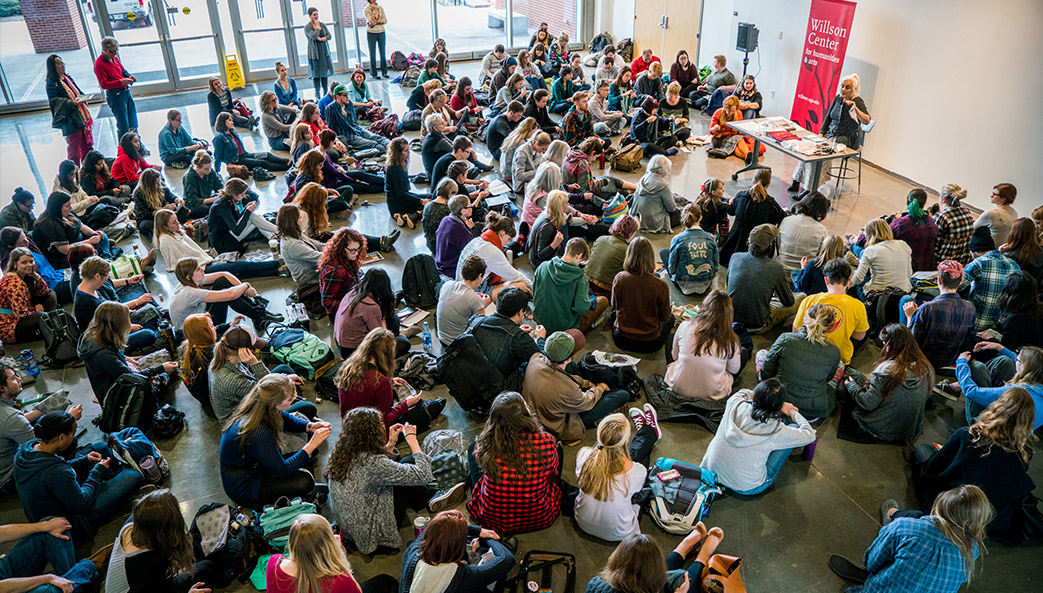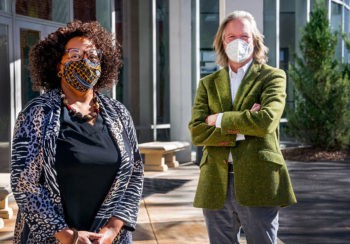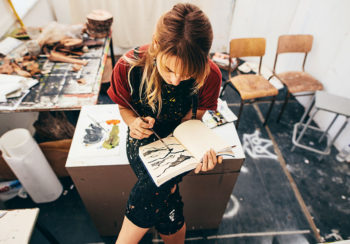In a brightly daylit dining hall on St. Helena Island, S.C., early last summer, about two dozen people stood shoulder-to-shoulder around long tables, submerging 3-foot by 3-foot pieces of fabric—not to mention their hands, forearms, elbows and, in some cases, sleeves—in deep vats of indigo-dyed water.
After the tightly bunched and banded cotton squares had absorbed the rich blue coloring, they were unwrapped, rinsed and wrung, then draped from a long clothesline just behind the building to dry, each revealing a unique, semi-orderly, photo-negative Rorschach pattern as they swayed beneath the reaching live oaks.
The dining hall is at Penn Center, one of the most venerable Black American cultural and historical institutions in the United States. Students, faculty and guests from the University of Georgia and six other institutions—including Atlanta universities Spelman College, Morehouse College and Emory University—gathered for the first cycle of summer student research residencies for Culture and Community at the Penn Center National Historic Landmark District.
The Culture and Community program is a multiyear partnership between Penn Center, located in the heart of the Gullah Geechee Cultural Heritage Corridor, and UGA’s Willson Center for Humanities and Arts. Funded by a $1 million grant to the Willson Center from the Mellon Foundation, the project was launched in 2021 to support education and culture-sharing among communities in the Sea Islands region, a chain of tidal and barrier islands that for centuries have been the home of the Gullah Geechee people.
“The Culture and Community collaboration has brought participants from throughout the Southeast to this vibrant repository of history and culture to discuss Gullah Geechee people, places, language, foodways, rituals, landscapes, songs and stories,” said Barbara McCaskill, professor of English at UGA and a Willson Center associate academic director.
“Through all of its programs, this project has exemplified the major role the humanities and arts can and must play to preserve Gullah Geechee communities and to prepare future generations to sustain them.”
“Through all of its programs, this project has exemplified the major role the humanities and arts can and must play to preserve Gullah Geechee communities and to prepare future generations to sustain them.”
–Barbara McCaskill, professor of English at UGA and a Willson Center associate academic director
(Photo by Tayelor Morgan)
Among the programs to which McCaskill refers, these research residencies comprise one of Culture and Community’s three public pillars, along with annual artist residencies and a series of public conversations on topics of relevance to members of the Sea Islands Gullah Geechee communities.
McCaskill and Nicholas Allen, Baldwin Chair in Humanities and director of the Willson Center, are the project’s principal investigators and serve on its steering committee with Penn Center board chair Deloris Pringle and interim director Bernie Wright, and Valerie Babb of Emory University. Research coordinator Angela Dore oversees the partnership’s day-to-day operations.
The spirit of hope
Penn Center sits on a sprawling campus with a history that began during the Civil War. It was founded as an institution for the education of African Americans who, until then, had been enslaved in the Sea Islands region. The Penn School served Black students for more than 80 years until its closure in 1948.
The site found a new purpose in the 1960s, when the campus served as a refuge in the segregated South for interracial groups of civil rights organizers, who could gather there in secluded safety. Martin Luther King Jr. is said to have drafted parts of his “I Have a Dream” speech during one of his stays at Penn Center’s Gantt Cottage.
The center now preserves, teaches and celebrates Black American culture and history, especially that of the Gullah Geechee.
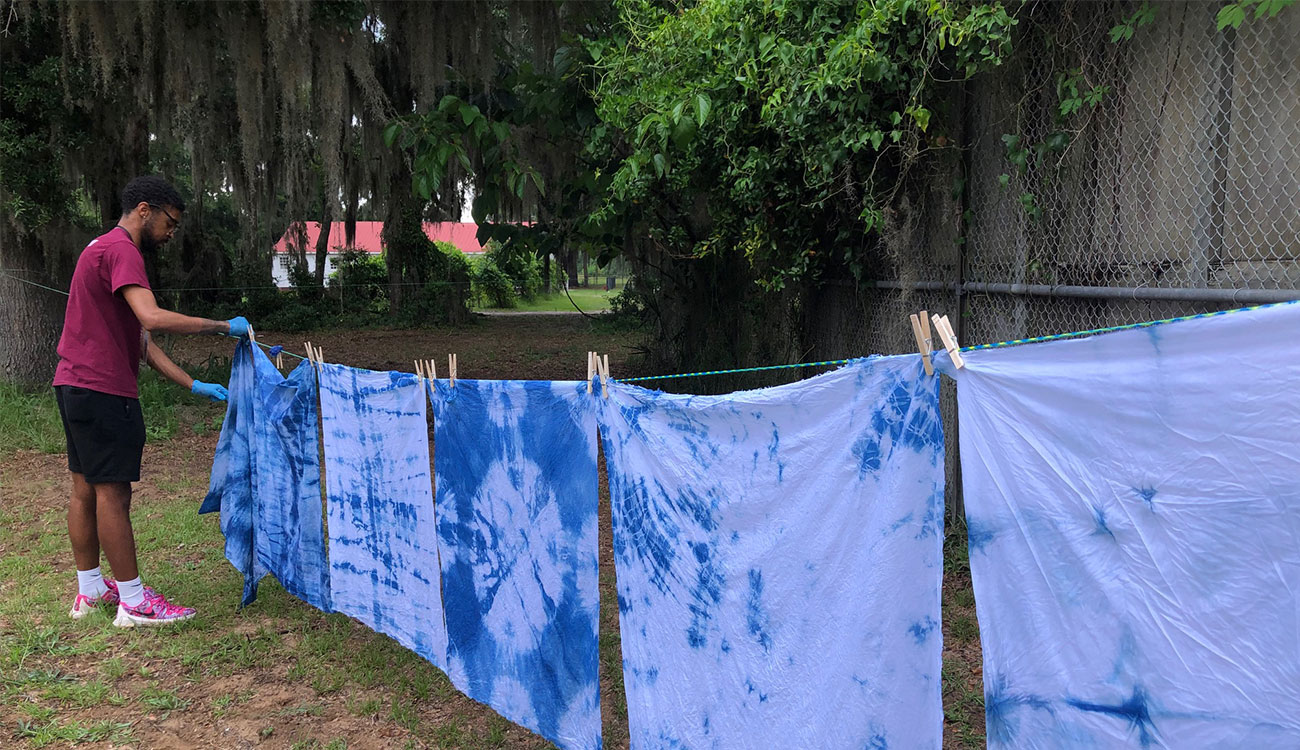
The indigo-dyeing workshop in the dining hall was led by UGA Professor Nik Heynen and Maurice Bailey, co-directors of UGA’s Cornelia Walker Bailey Program on Land and Agriculture on Sapelo Island, Ga. That program, named for Maurice Bailey’s mother, engages with questions surrounding the history, present status and future of agriculture, property politics and related issues on Sapelo.
Heynen and Bailey, who also directs the nonprofit Save Our Legacy Ourself, have worked together for years to help revive historic crops on Sapelo (including the indigo being used in the workshop). Their work has been featured in The New York Times.
The Penn Center residencies are built around dedicated courses at the participating colleges and universities. The workshop was tied to a class Heynen taught as visiting faculty in the Food Studies Program at Spelman College. McCaskill and Valerie Frazier, associate professor of English and director of the 1967 Legacy Program at the College of Charleston, both led students in on-site research and learning activities for credit at the students’ home institutions.
To McCaskill, the week of the residencies was the highlight of the Culture and Community partnership’s first year.
“St. Helena Island’s people, art, music, sacred traditions and landscape invite our contemplation of the faith and resilience that Gullah Geechee families have forged and the unique culture they have created,” she said. “I feel the spirit of hope that Dr. King, Septima Clark and other activists who walked beneath these old live oaks experienced. I feel the waves of uncertainty and risk among the formerly enslaved as they heard the Emancipation Proclamation read to them and dreamed of when they could read it for themselves.”
A life-changing residency
The indigo workshop was held on the second of the residencies’ four days of activities. On the first, the students had been introduced to Emory Shaw Campbell, the Culture and Community project’s community research partner and, for 22 years, Penn Center’s executive director (1980-2002). Campbell is an authoritative presence—tall, with a gentle smile, brimming with a profound knowledge. He gave the students a tour of the Penn campus and shared some of its history.
Tayelor Morgan, a sophomore 1967 Legacy Scholar at the College of Charleston, was deeply moved by that history.
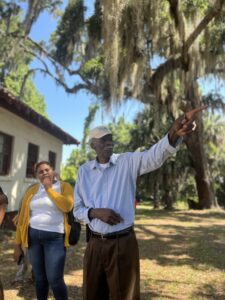
“My Mom and her family are from John’s Island, S.C., so they’re of the Gullah culture,” Morgan said. “I really didn’t know much about it because it’s not taught in schools. This residency, for me, has been an eye-opener. I’m so glad I came here.”
The students also attended a workshop on the 15th Amendment with Charles S. Johnson III, retired vice president of Tuskegee University; toured Penn’s York W. Bailey Museum with its docent, Marie Gibbs; and had an early-evening conversation with local artist Lisa Rivers about her exhibition of paintings, “A Gullah Homecoming.”
On the residencies’ third day, the participants boarded a bus to Hilton Head Island, S.C., to meet Thomas Barnwell—one of the Sea Islands’ most accomplished and respected Gullah Geechee elders—at his property, where he has worked with local historians, architects and historic preservationists to restore and research an 18th century tabby structure that had fallen into ruin. The students learned the story of the white planters and enslaved families who once inhabited this place, and how its history was unearthed and the structure rebuilt.
From Barnwell’s farm they continued to Mitchelville Freedom Park, where they enjoyed an alfresco lunch of authentic Gullah Geechee cuisine. Thomas Baker, the meal’s chef, captivated the diners by recounting the history and cultural context of each dish as he prepared it. The park’s executive director, Ahmad Ward, then guided the group on an educational walking tour of the historical site of Mitchelville, the United States’ first self-governed community of formerly enslaved African Americans.
One of the students who travelled to St. Helena was Cameron Nesmith, whose research interests as a graduate student in UGA’s Master of Historic Preservation program include the preservation of African American history and heritage, and also diversity and inclusion in the National Park Service. He viewed his Penn Center residency as life-changing.
“Physically, emotionally and spiritually, the experience of being at the Penn Center connected me to the history and souls of those who paved the way for someone like me,” he said. “From the architecture to the salty smell of St. Helena Island, to the welcoming aesthetic of the environment, at Penn Center you feel, breathe and see the Gullah-Geechee history that so many Americans do not know.”
‘Time is not frozen, dreams are not dead’
On the final day of their residency, students spent the morning tending the Penn Center community vegetable garden. That evening they shared reflections on their experiences with their instructors and each other.
Many, including Na’Zyia Dowdy-Arnold, a sophomore at Spelman who intends to study law, talked about returning for next year’s program or spending a week helping Bailey with his heritage crops on Sapelo.
“I’ve never felt more inspired,” Dowdy-Arnold said. “I’ve never felt more cultivated. I feel like I could take this knowledge that I’ve learned and share it with so many people.”
The Culture and Community partnership’s second round of Student Summer Research Residencies will take place in May 2023. McCaskill is coordinating plans for two sessions this year, one titled “Community-Engaged Traditions and Practices” and the other reprising the first year’s theme: “Land, Liberation and Justice.” The project’s organizers at Penn Center and the Willson Center are also working together on a new series of community conversations and a second artist residency for the program’s public offerings in 2023.
Outside the Emory Campbell Dining Hall on the June afternoon of Bailey and Heynen’s workshop, the participants had all finished eating lunch and were continuing their conversations while taking their dyed creations down from the clothesline. The big, blue squares with their near-symmetrical designs, both like the others and brilliantly unique, were barely dry.
Soon, they would be folded, packed up and brought home to Athens, Atlanta, Chapel Hill, Lexington and other hometowns to be hung on walls, or in windows, filling them with their indigo glow—each one carrying a deep and dense history, as well as memories of those few days on St. Helena.
“To visit Penn Center is to walk back in time,” McCaskill said. “It is also to realize that time is not frozen, dreams are not dead and as educated citizens we all have meaningful roles to play in creating caring and sustainable communities, wherever we land.”




